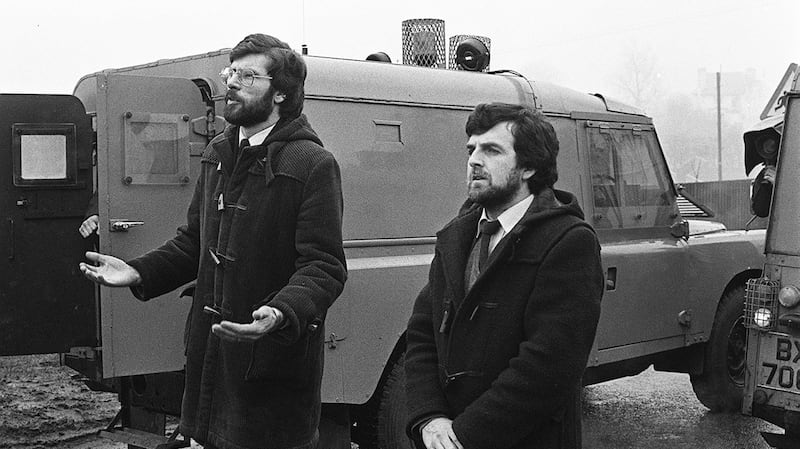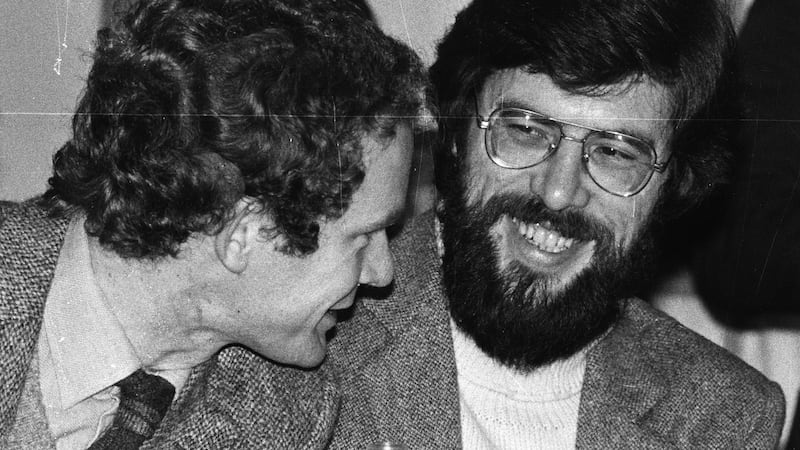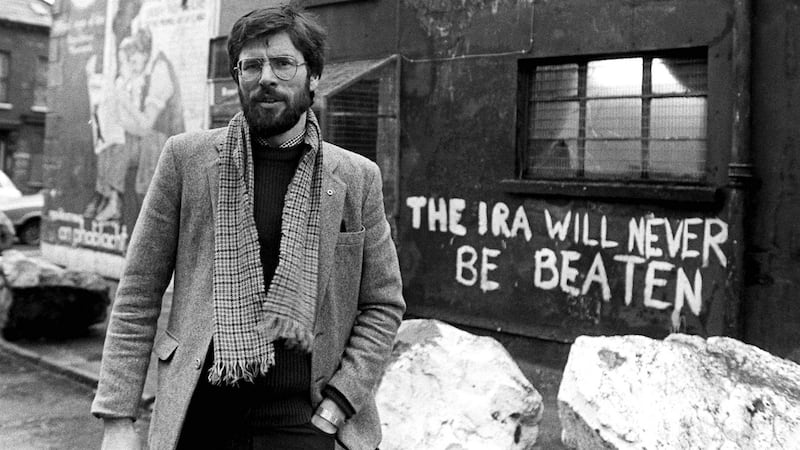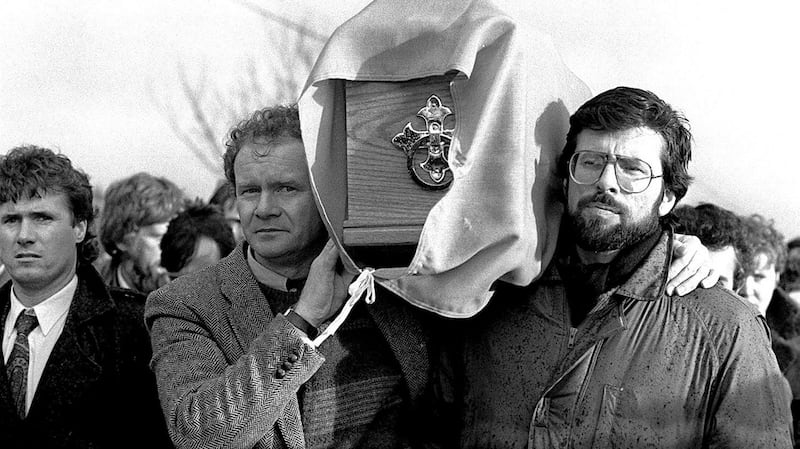Declaring to the BBC's Andrew Marr that his struggle for a united Ireland was not a failure, Gerry Adams made an implausible claim: the target had not been missed as Sinn Féin had bagged half a million votes . . . and still counting.
Success having many parents and failure an orphan, it is perhaps not surprising that Gerry Adams would seek to adopt something that might be loosely called success even if the goalposts had to be moved right off the pitch.
As the Provisional IRA’s strategic primus inter pares for many years, it is a bitter pill for the alpha and omega of armed struggle to swallow that the IRA’s campaign considerably underachieved.
Sinn Féin now fully embraces the British terms for unity, only by the consent of a majority in the North: by implication, a stark repudiation of the IRA’s methodology of coercion throughout the Troubles.

Better known publicly in 1970 for his letters as a Sinn Féin cumann PRO, protesting British army harassment, Adams was at the same time assiduously developing within the ranks of the Ballymurphy IRA, where he was the local commander.
In a calculated bid to build up community resentment that would morph into support for a revitalised IRA, he smothered the impulse of armed IRA volunteers to engage British troops during serious rioting over Orange marches.
It was the type of tactical ingenuity that would repeat itself a year later when the Belfast IRA's second battalion, which he now commanded, attacked the military and police in a bid to force Stormont's hand on internment. The calculation was that the draconian measure might be introduced long before RUC Special Branch had mastered the intelligence terrain.
As anticipated, internment was an intelligence debacle. Most senior IRA figures evaded the dragnet. Its one-sided application, followed by torture in Palace Barracks and elsewhere, so enraged the nationalist community that the IRA found a surplus of eager youth from which they could recruit.
Already it was clear that the IRA’s capability for strategic intelligence and action during the early years of the Troubles was coming to reside within the circles peopled by Adams and his coterie.
With the removal through arrest of Billy McKee as Belfast Brigade commander, his replacement, Joe Cahill, valued Adams's advice in a way that McKee was reluctant to, making the second battalion even more influential.
Arrested in March 1972, Adams’s release from internment in June of that year was secured only after the new leadership of the second battalion made clear that there would be no ceasefire if he was not freed.
That Belfast was now becoming the Provisionals' powerhouse was to be seen in the presence of three Belfast IRA leaders in the six-man delegation that travelled to London for talks with then Northern secretary William Whitelaw.
On the return journey to Ireland, despite chief of staff Seán Mac Stíofáin preferring a prolonged truce, the Belfast delegation decided that it would be broken, as it duly was.
‘The Disappeared’
On his June release from internment, Adams moved into the Belfast Brigade adjutant slot, a position he held at the time of the Bloody Friday bombings the following month. The first of “the disappearances” also began in June.
Belfast IRA man Joe Lynsky was killed and secretly buried. More such acts would follow. The "smoking gun" was never found in Adams's hand, but his handpicked squad, colloquially referred to as "the Unknowns", was deeply involved.
The three people who accompanied Jean McConville as she stood trembling at her secret graveside were members of the Unknowns, including the man who led it and answered directly to Adams.
Prominent IRA figures Brendan Hughes and Dolours Price, both now deceased, firmly contended that Adams was the architect of "the Disappeared", as well as being the one who took the bombing campaign to London.

Adams, however, has always denied involvement in “the disappearances”, just as he has always denied ever being a member of the IRA, unlike his longtime, now deceased, colleague Martin McGuinness.
By now, with the departure of Seamus Twomey to GHQ staff in October 1972, Gerry Adams was the Belfast Brigade commander. There, he won the unalloyed admiration of those who worked closely with him.
Despite being on a British army shoot-on-sight list, and billeted outside West Belfast in the evenings, each morning saw him travel into the heart of West Belfast – the area he would later represent as an MP – “to run the war”.
One colleague who later turned out to be an implacable opponent of the Sinn Féin leader observed that whatever attributes Adams lacked, “courage did not figure amongst them. He took serious risks.”
Running concurrent with much of this, Adams opposed IRA sectarian assassinations.
When Twomey was arrested towards the end of 1977, Adams moved into the vacant chief of staff spot, despite his denials that this occurred
He was particularly scathing of the killing in July 1972 in North Belfast of two Protestant brothers. The two men, Peter and Malcolm Orr, had gone out to meet their Catholic girlfriends. They were picked up by the Provisional IRA and shot dead.
Adams’s relationship with the man who led the killings was strained, though he later appointed that same individual, now deceased, to the heart of his personal security entourage.
This opposition to the targeting of Protestant civilians later came to the fore in 1976 when, from within prison, Adams fumed at the Kingsmill massacre of 10 workmen.
On release in early 1977 from prison, where he was a vehement critic of the 1975 IRA ceasefire, he went almost immediately to meet Seamus Twomey, by now serving a second term as chief of staff of the Provisional IRA, with his plans for a “long war”.
This was a military strategic vision for the most part put together by the late Pat Ward. When Twomey was arrested towards the end of 1977, Adams moved into the vacant chief of staff spot, despite his denials that this occurred.
His tenure came to be defined by the La Mon bomb attack which saw 12 Protestant civilians incinerated. The event brought his chief of staff spell to a close as he was arrested the following morning.

There is no reason to think Adams personally ordered the attack or knew about it. The most that can be said is that the operation was part of a wider incendiary bomb campaign that had been approved by the IRA’s army council.
Released from prison six months later, Adams’s return to the army council was delayed because there was by then no vacancy. Martin McGuinness was IRA chief of staff and Adams soon became his adjutant-general.
He retained the post until the assembly elections of 1982, by which time he had long since recovered his seat on the army council. It was an important period for the IRA and cemented the credentials of its increasingly northern leadership.
Major operations
Major operations like the killing of Lord Mountbatten and the Narrow Water attack at Warrenpoint on the same day in 1979, which claimed the lives of 18 Parachute Regiment soldiers, signalled the military acumen of the Long War leadership that had resolutely positioned itself against any form of ceasefire.
Adams was IRA adjutant-general during the hunger strikes. He also developed a practice that would become most pronounced during the peace process: the authority of the army council was gradually usurped as its power incrementally haemorrhaged to committees managed by Adams.
Richard O'Rawe has persuasively demonstrated that the offer to end the hunger strike which Danny Morrison claims to have "described to the hunger strikers, including Joe McDonnell", was rejected by Adams's committee and the prisoners' acceptance of the offer overruled.
The arrest of Ivor Bell and his subsequent detention in prison for six weeks was, according to British security strategists, the key moment in the ultimate defeat of the IRA campaign
After the assembly elections at the end of 1982, the IRA decided that its members holding elected office could not at the same time hold down “army briefs”.
This did not affect either Adams or McGuinness in respect of their army council roles. But it did bring to a close Adams’s hands-on day-to-day management of the IRA organisation in posts such as chief of staff and adjutant-general.

At this point the balance of power in the army council was 4-3, with those not enamoured with the current electoral strategy in the ascendancy. That changed courtesy of the RUC’s supergrasses strategy.
The arrest of Ivor Bell and his subsequent detention in prison for six weeks was, according to British security strategists, the key moment in the ultimate defeat of the IRA campaign. With shifting allegiances, Adams now had five in favour of the electoral strategy.
With the sidelining of Bell and others in prison for two years, substantive obstacles to the emergence of a peace process had been removed. From that point on Gerry Adams’s position on the army council remained for the most part secure, up until 2005 when the IRA announced an end to its war.
The one serious challenge to his hegemony, from those who went on to form the Real IRA, was averted by a unanimous decision by the army council in February 1996 to end the ceasefire it had declared two years earlier.
The result was the devastation of Canary Wharf. Even though Manchester in the same year would be subject to a similar attack, there was only one direction in which the Provisional Republican Movement was headed, the road of peace.
Anthony McIntyre is a former Provisional IRA member, writer and historian, and a longtime critic of Gerry Adams. He was imprisoned for murder for 18 years in Long Kesh, spending four of those years on the “no-wash” protest.









